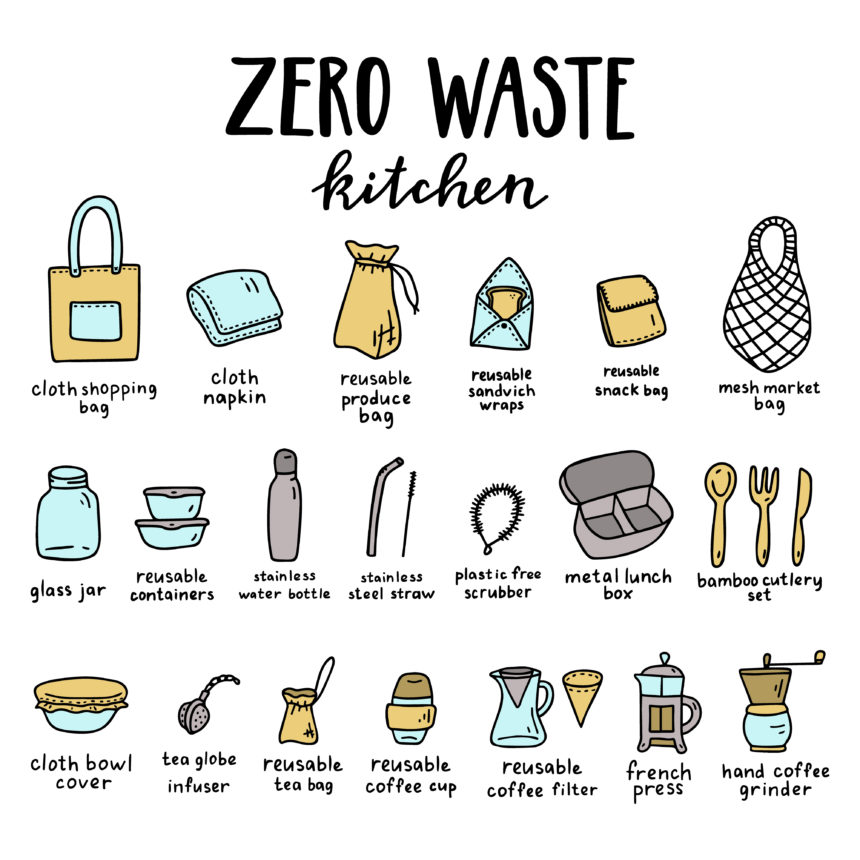Zero-Waste Kitchen Swaps You Need to Make

Are you tired of continuously producing waste in your cooking area? Do you wish to make a favorable impact on the environment however do not know where to start? Fortunately, with a couple of easy swaps, you can reduce your waste and welcome a sustainable lifestyle.
In this article, we’ll discuss zero-waste kitchen swaps that you need to make today. These eco-friendly alternatives will not just help you reduce your carbon footprint but also save you cash in the long run. We comprehend that going zero-waste can seem overwhelming, however taking small steps can make a significant distinction.
From reusable food wraps to composting, we’ll cover everything you need to understand to make your kitchen area more sustainable. It’s time to act and make a change. Let’s dive into the world of zero-waste kitchen swaps and begin living a more environmentally friendly life.
Benefits of Zero-Waste Kitchen Swaps
Zero-waste kitchen swaps are an effective way to decrease the carbon footprint and decrease the quantity of waste your home produces. Making simple changes in the way we live can have a substantial impact on the environment and our health.
Here are a few benefits of making zero-waste kitchen swaps that will assist you to make a positive effect on the world:
1. Minimize the amount of trash
Changing to reusable containers, cotton or mesh produce bags, and beeswax covers rather of plastic ones can substantially decrease the quantity of garbage your household produces. According to the Environmental Protection Agency (EPA), plastics account for 12% of overall solid waste, which ends up in landfills and oceans. Lowering plastic waste can make a significant distinction in lowering the quantity of trash that goes to landfills or contaminates our oceans.
2. Cut down on greenhouse gas emissions
Food waste in land fills produces a considerable quantity of methane gas, a potent greenhouse gas contributing to environment change. By composting food scraps, utilizing reusable containers, and shopping at bulk stores, we can minimize the quantity of waste we add to garbage dumps and consequently lower our carbon footprint.
3. Save money
Zero waste kitchen swaps also save you cash in the long run. By lowering the amount of packaged food you purchase, going shopping in bulk, and using reusable containers, you can save money on groceries. In addition, buying reusable products such as stainless steel straws and food containers can save you money by removing the requirement to purchase disposable, single-use products.
Swaps for Single-Use Items
Single-use items, like plastic straws, are some of the most inefficient and unnecessary items found in most cooking areas. Here are some eco-friendly swaps you can make to lower your plastic footprint:
1. Swap Plastic Straws for Reusable Stainless-Steel Straws
According to a study by Plastic Oceans International, Americans utilize an estimated 500 million plastic straws every day. These straws frequently wind up in landfills, rivers, and oceans where they take hundreds of years to decompose. Reusable stainless-steel straws are an excellent alternative that will last for years and can quickly be cleaned up with a straw brush.
2. Swap Plastic Wrap for Beeswax Wraps
Instead of utilizing single-use plastic wrap, attempt beeswax wraps, which are made from cotton fabric covered with beeswax, tree resin, and jojoba oil. These covers can be utilized much like plastic wrap, and they are washable and recyclable for as much as a year.
3. Swap Paper Towels for Reusable Cloth Towels
Paper towels are another regularly used single-use item in lots of kitchen areas. Rather of utilizing disposables, attempt utilizing recyclable cloth towels that can be washed and used again.
Sustainable Food Storage Solutions
Are you tired of tossing away food and using disposable containers that add to garbage dumps? If so, examine out these sustainable food storage options that can help you decrease waste in your kitchen area:
1. Reusable Containers: Using recyclable containers is one of the finest ways to reduce waste in your cooking area. Not only do they minimize waste, but they also keep your food fresher for longer.
2. Glass Jars: Glass containers are another terrific alternative for food storage. They can be found in different sizes and can be utilized to store dry items like pasta, rice, or nuts, in addition to liquids like soups or sauces. Plus, they are easy to tidy and are recyclable.
3. Stainless-steel Containers: Stainless-steel containers are resilient and long-lasting, making them an environment-friendly alternative to plastic. They are ideal for loading lunches or saving remaining food. Plus, they are lightweight and simple to bring around.
Embracing Reusable Kitchen Accessories
When it pertains to reducing waste in the kitchen area, among the most effective ways to begin is by embracing reusable cooking area accessories. These environment-friendly swaps not just help in reducing waste but also save cash in the long run. Below are some choices you can explore:

1. Multiple-use Bags
Change from single-use plastic bags to multiple-use bags when grocery shopping. Recyclable bags are long lasting, been available in various sizes, and can be easily stored in your bag or cars and truck for impromptu shopping trips.
Beeswax covers are a sustainable and eco-friendly alternative to plastic wrap. These covers are made with cotton fabric covered in beeswax, which create a natural seal around food items. They can be cleaned, dried, and reused for up to a year.
3. Food Huggers
Food huggers are silicone covers that grip onto cut produce, such as avocados and onions, to maintain their freshness and lower waste. They can be found in different sizes and colors, making them a fun and useful addition to any kitchen.
4. Swedish Dishcloths
Swedish dishcloths are a sustainable option to paper towels. These dishcloths are made with a blend of cotton and cellulose, which makes them absorbent and eco-friendly. They can be recycled and composted after they reach completion of their life-span.
5. Compostable Dish Brush
Switch your plastic dish brush for a compostable option made with natural materials, such as bamboo and plant fibers. These brushes are resilient, efficient, and can be disposed of in a garden compost bin after use.
By embracing these reusable kitchen accessories, you can considerably decrease waste in the kitchen and make a favorable effect on the environment. Simply keep in mind, every little contribution counts!
Avoiding Food Waste in the Kitchen
Minimizing food waste is a key element of a zero-waste kitchen. According to the USDA, roughly 30-40% of the food supply in the United States is wasted, resulting in environmental, economic, and social effects. Here are some simple swaps you can make to lower food waste in your cooking area:
1. Plan Your Meals
Meal planning is one of the most efficient methods to decrease food waste. Before heading to the grocery store, spend some time to plan your meals for the week. This will permit you to buy only the necessary active ingredients and avoid impulse purchases that may go to waste.
2. Store Your Food Appropriately
Appropriate food storage is vital to preventing food from ruining or going to waste. Keep vegetables and fruits in the fridge, and store them separately to prevent premature spoilage. Think about investing in multiple-use fruit and vegetables bags instead of plastic bags to reduce waste.
3. Get Creative with Leftovers
Do not let your leftovers go to waste! Repurpose them into brand-new dishes or freeze them for later on use. For example, Leftover cooked pasta and sauce can be turned into a pasta bake or used as a topping for a homemade pizza.
4. Utilize a French Press or Multiple-use K-Cup
If you’re a coffee enthusiast, consider switching to a French press or a reusable K-cup instead of single-use coffee pods. This basic swap can substantially decrease your plastic and paper waste while still enjoying your morning cup of Joe.
5. Buy Loose Fruits and Veggies
Buying loose vegetables and fruit instead of pre-packaged ones can also decrease food waste. Not only is it a more sustainable alternative as it doesn’t need the use of plastic packaging, but it also allows you to acquire only the quantity you require, lowering the opportunities of buying excessive and wasting it.
Also read: The Importance of Implementing the 5Rs of Waste Management
Shopping Sustainably
Shopping sustainably is a great way to lower waste in your kitchen area and embrace a more eco-friendly lifestyle. Here are some zero-waste shopping swaps to consider:
1. Buy in bulk: One way to reduce waste and save money is to buy in bulk. This will help you reduce single-use packaging and reduce your carbon footprint.
2. Local Farmers Market: Shopping at regional farmers markets offers lots of advantages. Not only are you supporting regional farmers and the community, however you are also decreasing waste. Farmers market fruit and vegetables is often not covered in plastic, and can be bought without product packaging. This is a terrific way to reduce your carbon footprint and support regional companies.
3. Buy local: Besides shopping at farmers market, try purchasing from local farmers directly. They normally have a farm stand or some sort of regional fruit and vegetables store. Avoiding supermarket and purchasing local has a major impact on decreasing waste and adds to your local community.
4. Thrift shop finds: Shopping at your local thrift store can be advantageous for the environment along with for your wallet. Buying used products like kitchen area equipment, decor, and kitchen tools is a fantastic method to decrease waste in addition to save money.
5. Ditch single-use bags: Bringing your own reusable bags with you to the grocery store is an easy and effective way to minimize waste. Reuse whatever bags you might already have, or purchase some reusable grocery bags for future shopping trips.
6. BYO containers: Finally, consider bringing your own containers to the store. Try using glass instead of plastic containers, for a longer lasting and reusable option.
Upgrading Kitchen Appliances
Are you looking to make your kitchen area more eco-friendly and reduce your waste? Upgrading your kitchen home appliances is a great method to go! Here are seven vital kitchen swaps to make a positive effect on the planet:
1. Bid Farewell to Old Appliances: Old devices can be one of the greatest culprits of energy waste in the cooking area. Replacing your outdated kitchen devices, such as your fridge, microwave or stove, with energy-efficient designs can save you money on your electrical energy expense and reduce your carbon footprint.
2. Invest in a Dutch Oven: Dutch ovens are excellent for cooking one-pot meals and reducing the need for multiple dishes. They reduce the amount of water used in cooking and decrease cooking times.
3. Say Farewell to Plastic Containers: It’s time to state goodbye to single-use plastic containers. Invest in glass or stainless steel containers instead, which can be used over and over once again. These will not only save you cash, but they will also decrease the amount of plastic waste winding up in garbage dumps..
4. Switch to Recyclable Water Bottles: Another way to reduce plastic waste in the kitchen is to use refillable water bottles. It is very important to make certain that the bottle is BPA-free and durable to guarantee long-term usage.
5. Choose Smaller Sizes: When grocery shopping, attempt to go with smaller-sized items, specifically when it concerns condiments and liquids. This minimizes the possibility of food waste and makes sure that you make use of all that you have actually acquired.
6. Accept Your Local Market: Shopping at your local farmer’s market is an excellent way of promoting zero-waste as a sustainable way of life. At these markets, you can acquire in-season produce and lower the carbon footprint of long-haul transport and product packaging waste.
7. Composting: Composting food scraps is an excellent way of lowering waste and making usage of food waste by turning it into nutrient-rich soil for your garden. Keeping a garden compost bin in your kitchen not just decreases waste in garbage dumps however also provides the benefits of natural fertilizers.
Also read: The Ultimate Guide to Zero Waste Living
Conclusion
By implementing these zero-waste kitchen swaps, you can make a significant impact on the environment and reduce your carbon footprint. Start making a positive impact today! Don’t forget to share this post with your friends and family to spread awareness and encourage others to make eco-friendly choices.





